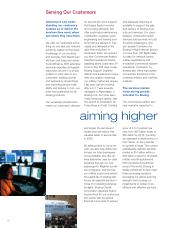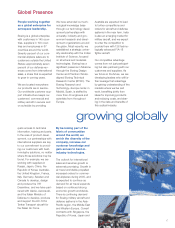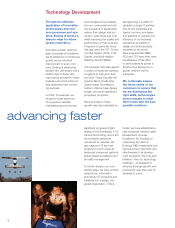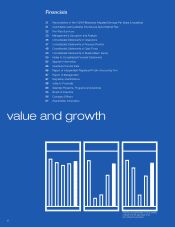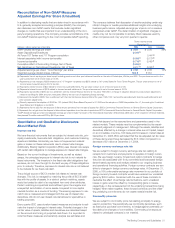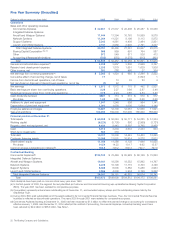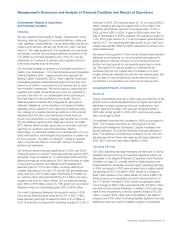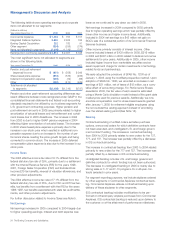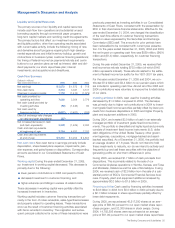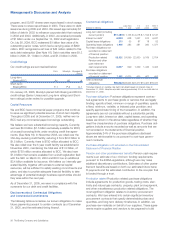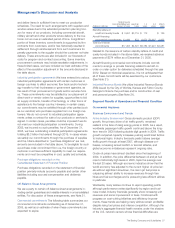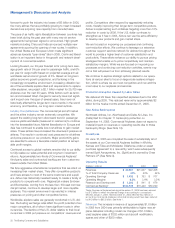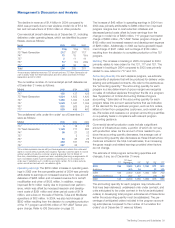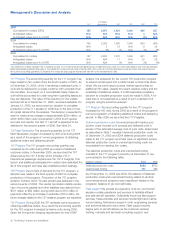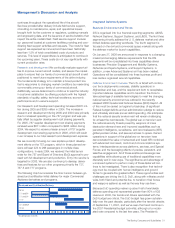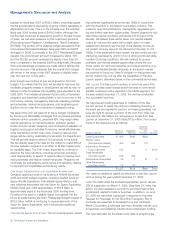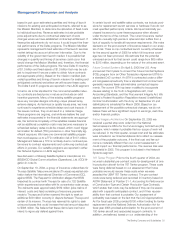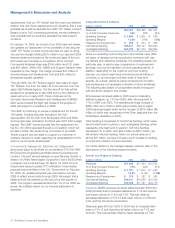Boeing 2005 Annual Report Download - page 26
Download and view the complete annual report
Please find page 26 of the 2005 Boeing annual report below. You can navigate through the pages in the report by either clicking on the pages listed below, or by using the keyword search tool below to find specific information within the annual report.
Management’s Discussion and Analysis
The following table shows operating earnings and corporate
items not allocated to our segments:
(Dollars in millilons)
Year ended December 31, 2005 2004 2003
Commercial Airplanes $«1,432 $««««753 $«707
Integrated Defense Systems 3,890 2,925 766
Boeing Capital Corporation 232 183 91
Other segment (334) (535) (379)
Items not allocated to segments (2,408) (1,319) (787)
Earnings from continuing operations $«2,812 $«2,007 $«398
The most significant items not allocated to segments are
shown in the following table:
Year ended December 31, 2005 2004 2003
Pension and post-retirement
(expense)/income $«««(851) $«««(258) $ 206
Share-based plans expense (852) (576) (456)
Deferred compensation expense (265) (72) (68)
Other (440) (413) (469)
Total items not allocated
to segments $(2,408) $(1,319) $(787)
Pension and other post-retirement accounting differences rep-
resent difference between costs recognized under GAAP in the
consolidated financial statements and federal cost accounting
standards required to be utilized by our business segments for
U.S. government contracting purposes. Higher pension and
post-retirement amounts in 2005 are primarily related to higher
amortization of actuarial losses and net settlement and curtail-
ment losses due to 2005 divestitures. The increase in 2004
from 2003 is due to higher GAAP pension expense in 2004
reflecting higher amortization of actuarial losses. The increase
in 2005 share-based plans expense is primarily due to the
increase in our stock price which resulted in additional com-
pensation expense due to an increase in the number of per-
formance shares meeting the price growth targets and being
converted to common stock. The increase in 2005 deferred
compensation plans expense is also due to the increase in our
stock price.
Income Taxes
The 2005 effective income tax rate of 9.1% differed from the
federal statutory tax rate of 35%, primarily due to a settlement
with the Internal Revenue Service (IRS) for the years 1998-
2001, Foreign Sales Corporation (FSC) and Extraterritorial
Income (ETI) tax benefits, reversal of valuation allowances, and
other provision adjustments.
The 2004 effective income tax rate of 7.1% differed from the
federal statutory tax rate of 35%, due to FSC and ETI tax ben-
efits, tax benefits from a settlement with the IRS for the years
1986-1997, tax benefits associated with state tax audit settle-
ments, and other provision adjustments.
For further discussion related to Income Taxes see Note 5.
Net Earnings
Net earnings increased in 2005 compared to 2004 largely due
to higher operating earnings. Interest and debt expense was
lower as we continued to pay down our debt in 2005.
Net earnings increased in 2004 compared to 2003 primarily
due to higher operating earnings which was partially offset by
lower other income and higher income taxes. Additionally,
included in 2004 net earnings is a $42 million net gain on
BCC’s sale of a substantial portion of its Commercial Financial
Services business.
Other income primarily consists of interest income. Other
income included interest of $100 million in 2005, $219 million
in 2004 and $397 million in 2003 related to federal income tax
settlements for prior years. Additionally in 2005, other income
included higher income from marketable securities and an
asset impairment charge for certain investments in technology
related funds and partnerships.
We early adopted the provisions of SFAS No. 123R as of
January 1, 2005 using the modified prospective method. Upon
adoption of SFAS No. 123R, we recorded an increase in net
earnings of $21 million, net of taxes of $12 million, as a cumu-
lative effect of accounting change. For Performance Shares
awarded in 2005, the fair value of each award is estimated
using a Monte Carlo simulation model instead of the grant date
market price used for previous awards. Additionally, we now
amortize compensation cost for share-based awards granted
after January 1, 2005 for retirement eligible employees using
the non-substantive vesting approach instead of amortizing
over the stated vesting period (See Note 18).
Backlog
Contractual backlog of unfilled orders excludes purchase
options, announced orders for which definitive contracts have
not been executed, and unobligated U.S. and foreign govern-
ment contract funding. The increase in contractual backlog
from 2004 to 2005 primarily relates to new orders for the 737,
777, and 787. The increase was partially offset by a decrease
in IDS contractual backlog.
The increase in contractual backlog from 2003 to 2004 related
primarily to new orders for the 777 and 787. The increase was
partially offset by a decrease in IDS contractual backlog.
Unobligated backlog includes U.S. and foreign government
definitive contracts for which funding has not been authorized.
The decrease in unobligated backlog in 2005 is mainly due to
strong sales in C-17 and F-15 programs for multi-year con-
tracts awarded in prior years.
For segment reporting purposes, we include airplanes ordered
by other segments in Commercial Airplanes contractual back-
log. Commercial Airplanes relieves contractual backlog upon
delivery of these airplanes to other segments.
IDS contractual backlog includes modifications to be per-
formed on intracompany airplane purchases from Commercial
Airplanes. IDS contractual backlog is reduced upon delivery to
the customer or at the attainment of performance milestones.
24 The Boeing Company and Subsidiaries


